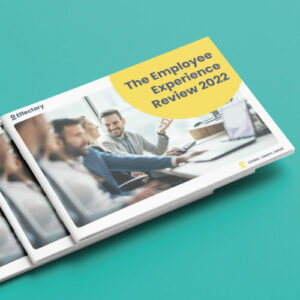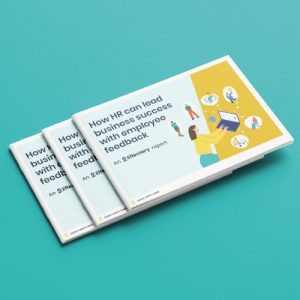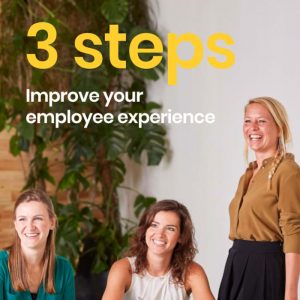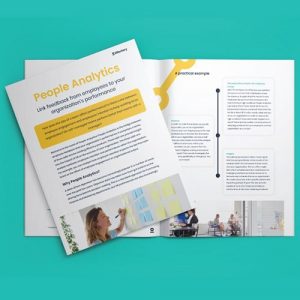The Employee Experience (EX) is a way to think about the employee journey in a holistic way. From onboarding to exit and ambassadorship, and all the points in between, EX is about boosting your employees’ (and thus your organization’s) success at every possible moment.
The Ultimate Guide to Employee Experience and HR

What is the Employee Experience?
The employee experience is about every part and aspect of an employee’s experience at work. Professor of Information Systems at San Diego State University Kaveh Abhari devised the idea of employee experience management in order to encourage organizations to think about their employees before they think about their clients or customers.
Gather feedback throughout the entire employee journey
Why? Because without engaged and committed employees, clients won’t receive a good experience when they interact with your organization, either when they’re first purchasing your product or service, or when they are seeking assistance with it.
If an employee isn’t being treated well or feels uncared for by their manager and organization, they’re unlikely to drive sales or increase customer satisfaction
This makes sense. After all, if an employee isn’t being treated well or feels uncared for by their manager and organization, why would they put in effort to help you drive sales or increase customer satisfaction?
This focus on the employee experience also expanded the scope of what HR should be thinking about in regards to the employees it looks after. These days, it’s not just about financial remuneration or resolving conflicts, but actively working to improve the employee experience.
Both professional and personal development, and much more besides, are important parts of the puzzle to make sure that the employee experience is world-class.
Download the Employee Experience Review
Discover how employees around the world are experiencing different parts of the employee journey and how this affects the employee experience.
DownloadThe relationship between the Employee Experience and the Employee Lifecycle
The employee lifecycle refers to the key moments of an employee’s relationship and interaction with an organization. Some of these “moments” occur only once, such as onboarding or exit, for example, while others, such as engagement, are continuous throughout their relationship with their organization.
Different people and organizations break the employee lifecycle into different segments. As we have written in our Employee Experience Review 2022 (EXR22), we see EX as being composed of:
- Onboarding
- Development
- Engagement
- Performance
- Exit
- Attract (Alumni & Referral)
We put Attract at the end to stress the importance that having ambassadors that refer talent to your organization is – even after they’ve left. The goal is retain a good relationship with all your employees, past and present.
The EXR22 is an expansive overview of employee sentiment to different moments of the employee experience. It’s based on world-wide data, and outlines how employee listening can be an important part of improving the employee experience throughout the employee journey.
What does the Employee Lifecycle have to do with the Employee Experience?
EX was first conceptualized to get organizations to boost client satisfaction by boosting employee engagement, and since then thinking about an employees’ experience at work has grown into a major part of the HR landscape.
If we think about each of the stages of the employee lifecycle as a moment in which to improve the employee experience, we can see how the two concepts neatly map onto each other, giving us a framework through which HR and management can strategically organize their people strategy so that it positively impacts the employee experience and lengthens the employee lifecycle.
It is true that EX and the employee lifecycle are not, strictly speaking, the same. There are factors such as IT and tech accessibility, interpersonal relationships, and much else besides that goes into EX which isn’t necessarily a part of the employee lifecycle.
However, given the prominent role HR has in both the employee lifecycle and employee experience, it is worth looking at how these two ideas can be thought alongside each other so that they complement and boost each other.
By delving into the six key stages of the employee lifecycle, we can discover numerous ways to boost the employee experience.
The six key stages of the Employee Experience
Onboarding
Onboarding takes place during an employee’s first weeks at an organization. This is when they need to become familiar with their tasks, what is expected of them, their teammates, and the organization as a whole.
The three most effective onboarding practices
Onboarding has changed dramatically since the pandemic and the rise of hybrid working. Traditionally, onboarding would take place in the workplace in person, giving people the opportunity to discover the atmosphere of an organization and meet their colleagues in a more organic way. But now, and especially for white-collar (and no-collar) office workers, it’s likely that their onboarding will be hybrid, or even fully virtually.
Onboarding in the age of hybrid work presents challenges for making new hires really feel like part of a team
This presents challenges to HR and management. After all, it’s quite difficult to make someone feel part of something and connected with their colleagues and the organization if they’re mostly sat in their house, a library, coffee spot, or co-working space.
Looking to provide a personal touch, some organizations have decided to send new hires “goodie bags” with useful (and fun) gifts. It’s also been very important to make sure that new hires have all the materials they need to work remotely well, such as a comfy chair and functioning laptop, for example.
Onboarding Process of New Employees – Effectory
Making sure that there’s moments during the onboarding process for new hires to have short, informal virtual meetings with colleagues has also proved vital. This gives people the opportunity to get to know each other outside of speaking about specific projects or duties. With retainment in mind, others have policies in place which assists their hybrid and remote workers to attend events and team days at the office.
Development
Although you’ve no doubt taken care to make sure that you’ve picked the right candidate for the job, there’s always room for someone to gain new skills and develop. In fact, offering employees the ability to “learn on the job” is a great way to keep them engaged, and also to help bring junior staff into more senior positions.
Traditionally, development opportunities were provided in the form of off-site days, or giving employees time off to attend short term courses. As technology has progressed, there’s now a wealth of platforms where people can attend virtual courses on subjects ranging from SEO expertise to improving the sales process.
But development doesn’t just have to take place in a formal way. Don’t forget that your senior staff and management have skills and expertise which many others in your organization would like to learn. Increasingly, organizations are finding ways to incorporate learning and development opportunities into the daily or weekly workflow. They’re doing this by encouraging senior staff to mentor junior employees in managerial tasks, or transferring them more complex knowledge about the industry or professional focus of the team.
Aim for a culture where ongoing feedback, peer to peer coaching, and other ways of learning on the job are as important as formal educational programs
This is the approach that business software company Exact has taken. Its Chief HR Officer, Florien De Nijs, tells us that “one of our values is that we should ‘always be learning.’ So, we’re building a learning culture, but not a culture where learning is just training. We’re aiming for a culture where ongoing feedback, peer to peer coaching, and other ways of learning which you can do day-to-day on the job are as important as formal educational programs.”
Engagement
At this point, some people talk about retention, but retention is an end goal, not an activity. This is why we like talking about engagement: because being engaging encourages action.
While engagement is often discussed in isolation from other topics, it is in fact impacted and impacts every stage of the employee experience. If all the other stages of EX are working well, you’re much more likely to see high engagement levels.
And also, increasing engagement positively impacts other parts of EX. For example, high engagement corresponds with:
- 35% increase in job satisfaction
- 35% increase in employee retention
- 29% increase in customer focus
compared with non-engaged staff.
But what is employee engagement? Based on our research, employee engagement can most accurately be described as “the degree to which employees are inspired and energized by their work and experience a positive connection with their work environment.”
The difference Between Employee Experience and Engagement
80% of executives say the employee experience is either important or very important for them, yet only 29% of employees feel engaged or listened to. There’s a big gap between where companies want to be and where they are. It’s time to close this gap and engage employees.
It’s important to survey employees to find out how engaged they are, and to discover what could boost engagement in your organization. This will lead you to thinking about important topics that aren’t typically understood as part of EX, such as diversity & inclusion, sustainability, and workplace autonomy.
Simply put, engagement encourages you to think more holistically about every factor that impacts the EX, and working on engagement will in turn make your employee experience world-class. Who knows, perhaps your employees will even rate you a World-class Workplace?
How HR can lead business success
HR and employee listening are crucial to business success. Here is how employee insights can help your organization.
DownloadPerformance
So you have an engaged workforce who have access to development opportunities. But now you need to know how that translates to actions.
Employee performance is typically understood as the extent and quality with which an employee performs their duties and tasks. Effectiveness, quality and efficiency are metrics by which you can measure performance, and work out the value of an employee or team to the organization.
Good performance doesn’t come out of nowhere, and of course performance needs to be judged against something. Having clear job description goals, project goals, and behavioral goals is important for being able to measure performance in the first place. You can track performance by asking the employees themselves, their direct manager, and their colleagues.
Research by Deloitte found that:
- 90% organizations who had updated and upgraded their performance management processes saw improvements in employee engagement.
- 83% said they saw an increase in quality in the conversations between employees and their managers.
It’s important that performance reviews take place both formally and informally, so that employees feel like the organization is always taking their activities and progress into consideration. This can be done via weekly, monthly and quarterly catch ups, continuous feedback from colleagues and management, and the active identification of learning and development goals that people can work towards.
Exit
Thanks to the Great Resignation trend, employee exits have become a big topic in HR and business in general. The exit part of the employee lifecycle is when an employee decides to leave an organization, either for a new opportunity elsewhere, to retire, to change careers, or if they feel disengaged or disconnected from the organization.
Of course, employees don’t only jump, they can also be pushed. DDI research shows that most people “quit their boss.” Other “push” reasons include suffering from burnout and or experiencing a poor or unsafe company culture.
According to one report by Gallup, replacing an employee can cost from 50%-150% of that employee’s annual salary. The BBC have also reported on a phenomenon called “turnover contagion”, where multiple employees leave an organization at a short space of time. As the article says, there’s “a powerful psychological effect of seeing your peers leave, which can motivate you to start wondering if the grass is greener on their side.”
It’s not realistic to expect employees never to leave, especially not in the 21st century when changing careers is increasingly common. But it is possible to extend the time of the employee lifecycle – and thus increase your return on investment of a hire – by engaging an employee throughout their tenure, and making sure the employee experience is as good as possible.
You can also take steps to mitigate immediate factors that are encouraging employees to look for opportunities elsewhere. By surveying staff about their concerns and pressures right now, you can take actions to alleviate these and encourage them to stay.
Attract (Alumni & Referral)
Organizations have tended to rely on organic networks and word of mouth to attract the best talent. In the age of online reviews and social media, ensuring that you have a positive brand image is even more important.
Having a real and positive connection with your employees, especially by cultivating good team dynamics, will positively impact the likelihood of your employees being ambassadors. As will having a strong organizational vision and set of values that you make credible by showing you live by them with each decision you make.
Having a real and positive connection with your employees, will increase the likelihood of your employees being ambassadors for your brand.
If you’ve focused enough energy and effort on producing a great employee experience, both current and former employees should be happy to refer contacts to vacancies, review you positively on platforms such as Glassdoor, and maybe even be useful links for future collaborations with relevant partners. After all, people are likely to continue working in your organization’s industry.
Whitepaper: Attracting and retaining talent – 5 tips
In the War for Talent, attracting great people is increasingly difficult, especially for jobs that require lots of skill or experience. Don’t be left behind: always think about how your employee experience is about building a feedback loop between you and the outside world, which can in turn help you be more productive, innovative, and successful.
Employee experience in 3 easy steps
Learn the best ways to improve the employee experience in your organization with these 3 easy-to-follow tips! Get your copy today!
Download: employee experience tipsWhy your organization needs to care about the employee experience
As we’ve shown, by looking at the employee lifecycle, we can see the different stages at which the employee experience can be boosted.
A great employee experience can result in:
- Engaged staff
- High productivity
- Great employee retention
All of these affect a business’s bottom line, or a non-profits ability to perform well.
According to Forbes, businesses with the 25% rates of employee engagement receive 10% higher customer metrics. The employee experience is not only about your employees, it is about your customers and your partners.
HR specialist Josh Bersin conducted research into the benefits that the right EX strategy can bring to an organization. The outcomes are impressive. According to him, companies with a great EX are 2.2x more likely to exceed financial targets, are 5.1x more likely to engage and retain employees and are 3.7% more likely to adapt well to change.
Despite all the benefits of a great employee experience, research by Deloitte shows that 59% of executives reported they were not ready or only somewhat ready to address the employee experience challenge. There is still a lot of work to be done to bridge this gap.
Download the Employee Experience Review
Discover how employees around the world are experiencing different parts of the employee journey and how this affects the employee experience.
DownloadCreating a great employee experience is a long journey and an ongoing process. But by engaging employees and responding to their feedback through the employee lifecycle, it is possible to create a workplace that empowers and engages people.
It is also always worth thinking about your corporate purpose – is your organization meeting tomorrow’s challenges today? Are you thinking sufficiently about your employees’ work-life balance and hybrid working policies? This is only increasing in importance, as by 2030, 70% of the workforce in the USA will be composed of millennials, a generation who pay more attention to that subject.
We also live in a volatile world, and organization’s ability to respond on time and well to emergencies is going to prove critical to future performance.
How do you measure and analyze the employee experience?
With an employee listening partner like Effectory, you can run diagnostics on how your people are thinking and feeling about their experiences at work.
By performing surveys during the onboarding process and when people exit, you can get insights into two key points of the employee experience.
- Are new hires given all the tools they need to be productive and have autonomy at work as early as possible?
- And why are people leaving, is there anything you could do to extend the employee lifecycle?
In recent years, HR has transitioned from performing surveys at key points and once a year, to what is often referred to as continuous listening.
Continuous employee listening is about checking in with employees on key topics whenever necessary. Performing shorter pulse surveys on themes such as team dynamics or diversity and inclusion, for example, will give you instant insights on how your organization is performing in these areas.
Create impact with People Analytics
Link feedback from employees to your organization’s performance
DownloadPeople analytics for boosting the employee experience
After performing a survey, the Effectory platforms transforms the feedback into analyzable data.
Your results dashboard will show you in simple terms your employees’ sentiments on whatever you’ve surveyed them about. These results can be compared to our global benchmarks. Our platform also automatically highlights recurring words and sentiments given in open ended answers.
With an intuitive analytics dashboard, you can easily transform feedback into action points that can drive your people strategy and improve the employee experience.
And what’s more, by basing your policies on employee feedback, you’ll create a engagement and trust between you and your employees by making them feel engaged and part of organizational decision making.
Book a free demo. See our solutions in action.
Effectory is Europe’s Leading provider of Employee Listening Solutions. Schedule a product demo and discover how to enhance your employees’ engagement.
Demo request



